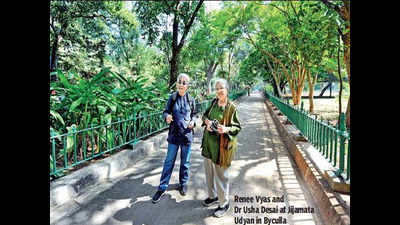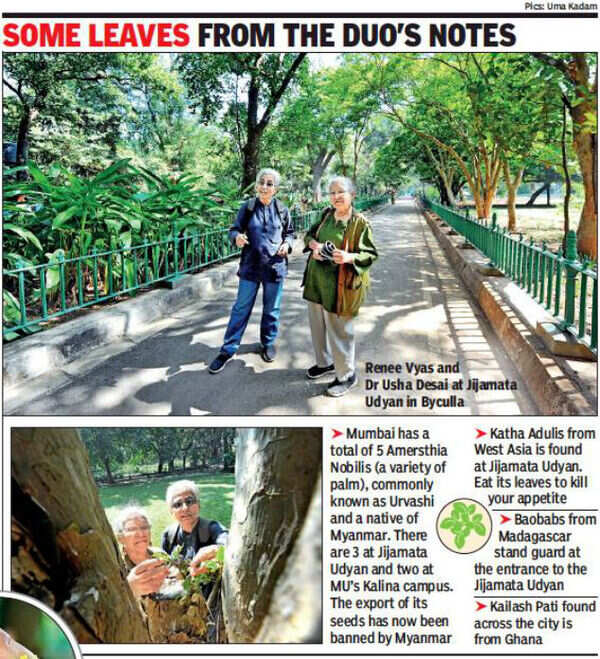- News
- City News
- mumbai News
- Two tree chroniclers help Mumbai unearth its natural treasures
Trending
This story is from January 2, 2019
Two tree chroniclers help Mumbai unearth its natural treasures

Renee Vyas and Dr Usha Desai, between them, can boast of more than 140 years of native wisdom. One is in her 60s and the other is 82 years old, but what binds them is love for trees and passion to share knowledge about the greens. Neither is a botanist. On January 13, the duo will hold their 100th Tree Appreciation Walk at Jijamata Udyan, Byculla.

Desai, who used to work at MGM Hospital in Parel, took an interest in trees during her morning walks to Jijamata Udyan.She was 50 then. “I got acquainted with Dr M Almeida (now deceased), a tree lover, during those walks and he inculcated a curiosity and love for plants in me. He inspired me to identify trees on the MGM campus and I even had them labelled,” says Desai.
For Vyas, a businesswoman, it was a course in gardening at St Andrew’s College, Bandra, where Almeida was a faculty. Pursuing their interest, Vyas and Desai joined a course at Bombay Natural History Society and started volunteering to teach others. The two began visiting gardens to identify trees—they would stop at a tree, walk around it, feel its bark, look closely at its flowers and fruits. And it was this “behaviour” around trees that caught people’s attention.
Vyas and Desai now work as a team. They select 20 trees in a garden, read up on them, make charts, take pictures and weave stories. They also rehearse together so that their accounts during the walks are consistent. They also conduct walks individually.
“We realised that if we would lecture like botanists, it would be a dry and boring talk. So, we decided to weave in stories,” says Vyas. Pointing to a Cannon Ball tree at Jijamata Udyan, she says this one is not a native Indian tree, yet it is associated with Lord Shiva and is locally known as Kailashpati. “This is because the flower has a hood and it looks like a hooded snake. Also, given its distinct shape, only the carpenter bee which feeds on pollen can enter and pollinate. The carpenter bee is nothing but the bhanwara of the ‘bhanwara bada nadaan hai’ fame. Such details help people remember the uniqueness of a tree,” she smiles.
Every time, there is a different themes for the threehour walk, which is conducted on one Sunday of every month. They have a Facebook page where they upload their schedule. “The most versatile is the BPT Gardens, where there are varieties of ficus, bamboo and other trees but the most difficult has been SGNP, Borivli,” they say.
“We do not conduct a walk unless we are absolutely sure about our facts. In a garden, it is easy to see a tree, go home, do our research and come back to look at the tree. But in the national park, we are not sure whether we will be able to locate the same tree again as it is a forest,” explains Vyas.
At Powai, the duo, through their meticulous research, was instrumental in helping the Hiranandanis identify several palm trees whose exact identity was unknown. The team has conducted walks on rare trees at Jijamata Udyan, mangroves in Bhandup, palms at Hiranandani Garden, aquatic plants at Dattaji Salvi Garden in Thane, in Aarey, and medicinal plants at Somaiya Hospital in Vidyavihar.
They rue that there are not enough experts to conduct such walks. “Now, we are learning about grass. So far, we have learnt about 18 varieties and, it is just the beginning.”

Desai, who used to work at MGM Hospital in Parel, took an interest in trees during her morning walks to Jijamata Udyan.She was 50 then. “I got acquainted with Dr M Almeida (now deceased), a tree lover, during those walks and he inculcated a curiosity and love for plants in me. He inspired me to identify trees on the MGM campus and I even had them labelled,” says Desai.
For Vyas, a businesswoman, it was a course in gardening at St Andrew’s College, Bandra, where Almeida was a faculty. Pursuing their interest, Vyas and Desai joined a course at Bombay Natural History Society and started volunteering to teach others. The two began visiting gardens to identify trees—they would stop at a tree, walk around it, feel its bark, look closely at its flowers and fruits. And it was this “behaviour” around trees that caught people’s attention.
“Once at the Colaba gardens, a woman, a regular walker, asked me if I was talking to the tree. When I told her we were learning about trees, she said she wanted to join us. And, that’s how in April 2010, we decided to hold our first Walk,” recounts Desai. While the number of those curious to learn has swelled, many have become regulars.
Vyas and Desai now work as a team. They select 20 trees in a garden, read up on them, make charts, take pictures and weave stories. They also rehearse together so that their accounts during the walks are consistent. They also conduct walks individually.
“We realised that if we would lecture like botanists, it would be a dry and boring talk. So, we decided to weave in stories,” says Vyas. Pointing to a Cannon Ball tree at Jijamata Udyan, she says this one is not a native Indian tree, yet it is associated with Lord Shiva and is locally known as Kailashpati. “This is because the flower has a hood and it looks like a hooded snake. Also, given its distinct shape, only the carpenter bee which feeds on pollen can enter and pollinate. The carpenter bee is nothing but the bhanwara of the ‘bhanwara bada nadaan hai’ fame. Such details help people remember the uniqueness of a tree,” she smiles.
Every time, there is a different themes for the threehour walk, which is conducted on one Sunday of every month. They have a Facebook page where they upload their schedule. “The most versatile is the BPT Gardens, where there are varieties of ficus, bamboo and other trees but the most difficult has been SGNP, Borivli,” they say.
“We do not conduct a walk unless we are absolutely sure about our facts. In a garden, it is easy to see a tree, go home, do our research and come back to look at the tree. But in the national park, we are not sure whether we will be able to locate the same tree again as it is a forest,” explains Vyas.
At Powai, the duo, through their meticulous research, was instrumental in helping the Hiranandanis identify several palm trees whose exact identity was unknown. The team has conducted walks on rare trees at Jijamata Udyan, mangroves in Bhandup, palms at Hiranandani Garden, aquatic plants at Dattaji Salvi Garden in Thane, in Aarey, and medicinal plants at Somaiya Hospital in Vidyavihar.
They rue that there are not enough experts to conduct such walks. “Now, we are learning about grass. So far, we have learnt about 18 varieties and, it is just the beginning.”
End of Article
FOLLOW US ON SOCIAL MEDIA










